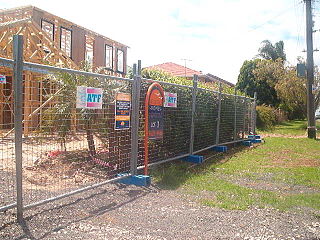 W
WIn the fields of physical security and information security, access control (AC) is the selective restriction of access to a place or other resource while access management describes the process. The act of accessing may mean consuming, entering, or using. Permission to access a resource is called authorization.
 W
WA biometric device is a security identification and authentication device. Such devices use automated methods of verifying or recognising the identity of a living person based on a physiological or behavioral characteristic. These characteristics include fingerprints, facial images, iris and voice recognition.
 W
WCrowd control barriers, are commonly used at many public events. They are frequently visible at sporting events, parades, political rallies, demonstrations, and outdoor festivals. Event organizers, venue managers, and security personnel use barricades as part of their crowd management planning.
 W
WAn electric fence is a barrier that uses electric shocks to deter animals and people from crossing a boundary. The voltage of the shock may have effects ranging from discomfort to death. Most electric fences are used today for agricultural fencing and other forms of animal control, although they are also used to protect high-security areas such as military installations or prisons, where potentially lethal voltages may be used.
 W
WAn electric gate is an entrance gate which can be opened and closed via an electric powered mechanism.
 W
WA fence is a structure that encloses an area, typically outdoors, and is usually constructed from posts that are connected by boards, wire, rails or netting. A fence differs from a wall in not having a solid foundation along its whole length.
 W
WFuture Fibre Technologies (FFT) is a fiber optic sensing technologies company based in Melbourne, Australia, with its US head office in Mountain View, California, Middle East head office in Dubai, Indian head office in New Delhi and European head office in London. Founded in 1994, Future Fibre Technologies product line provides optical fiber intrusion detection systems for perimeters, buried oil and gas pipelines and data communication networks.
 W
WA glass break detector is a sensor used in electronic burglar alarms that detects if a pane of glass is shattered or broken. These sensors are commonly used near glass doors or glass store-front windows.
 W
WHeras fencing is a brand of temporary fencing intended for use on construction sites. It consists of individual panels approximately 3.5 metres (11 ft) wide and 2 metres tall. Each panel consists of a metal tubing frame, with feet slotted into concrete or synthetic blocks. In the middle of the panel is a metal mesh. Heras Fencing is produced by Heras Mobile Fencing & Security, who first developed their temporary fencing in 1966.
 W
WAn iron railing is a fence made of iron. This may either be wrought iron, which is ductile and durable and may be hammered into elaborate shapes when hot, or the cheaper cast iron, which is of low ductility and quite brittle. Cast iron can also produce complicated shapes, but these are created through the use of moulds of compressed sand rather than hammering, which would be likely to damage the iron.
 W
WA perimeter intrusion detection system (PIDS) is a device or sensor that detects the presence of an intruder attempting to breach the physical perimeter of a property, building, or other secured area. A PIDS is typically deployed as part of an overall security system and is often found in high-security environments such as correctional facilities, airports, military bases, and nuclear plants.
 W
WPhysical security describes security measures that are designed to deny unauthorized access to facilities, equipment and resources and to protect personnel and property from damage or harm. Physical security involves the use of multiple layers of interdependent systems that can include CCTV surveillance, security guards, protective barriers, locks, access control, perimeter intrusion detection, deterrent systems, fire protection, and other systems designed to protect persons and property.
 W
WA rope line is a setting in which a major celebrity, i.e. movie star, musician, supermodel, politician, internet celebrity, interacts with the general public. A crowd control barrier – originally a rope but now typically a secure metal fence – separates the celebrity from the crowd. In American political terminology, a politician "walking down the rope line" or "working the rope line" is engaging with his supporters – hand shaking, chatting, signing autographs and providing photo opportunities.
 W
WA safety barrier is a component which prevents passage into a dangerous area, commonly used to mitigate risk. Safety barriers may be hard barriers physically restricting passage or soft barriers that control circuits based on the presence of foreign bodies.
 W
WTemporary fencing, as the name suggests, is a free standing, self-supporting fence panel, the panels are held together with couplers that interlock panels together making it portable and flexible for a wide range of applications. A common type of temporary fencing is Heras fencing. Fence panels are supported with counter-weighted feet, have a wide variety of accessories including gates, handrails, feet and bracing depending on the application. Fence panels are commonly constructed of either chain link or weld mesh.
 W
WWattle is a lightweight construction material made by weaving thin branches or slats between upright stakes to form a woven lattice. It has commonly been used to make fences and hurdles for enclosing ground or handling livestock. The wattle may be made as loose panels, slotted between timber framing to make infill panels, or it may be made in place to form the whole of a fence or wall. The technique goes back to Neolithic times.